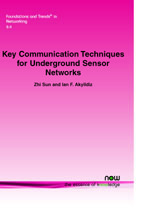Key Communication Techniques for Underground Sensor Networks
By Zhi Sun, Department of Electrical Engineering, State University of New York (SUNY) at Buffalo, USA, zsun@buffalo.edu | Ian F. Akyildiz, School of Electrical and Computer Engineering, Georgia Institute of Technology, USA, ian@ece.gatech.edu
Abstract
Wireless Underground Sensor Networks (WUSNs) are the networks of wireless sensors that operate in the underground soil medium. In this monograph, to realize reliable and efficient WUSNs, two enabling techniques are developed to address the challenges brought by the underground soil medium, including the EM wave-based WUSNs and the MI-based WUSNs. For EM wave-based WUSNs, the heterogeneous network architecture and dynamic connectivity are investigated based on a comprehensive channel model in soil medium. Then a spatio-temporal correlation-based data collection scheme is developed to reduce the sensor density while keeping high monitoring accuracy. For MI-based WUSNs, the MI channel is first analytically characterized. Then based on the MI channel model, the MI waveguide technique is developed in order to enlarge the underground transmission range. After that, the optimal deployment algorithms for MI waveguides in WUSNs are analyzed to construct the WUSNs with high reliability and low costs. Finally, the mathematical models are developed to evaluate the channel and network capacities of MI-based WUSNs. This monograph provides principles and guidelines for WUSN designs.
Key Communication Techniques for Underground Sensor Networks
Wireless Underground Sensor Networks (WUSNs) are the networks of wireless sensors that operate below the surface of the ground. The networks of wireless nodes are buried underground and communicate through soil. WUSNs can enable many novel and important applications, such as in-situ oil reservoir monitoring, concealed border patrol, underground power grid and pipelines maintenance, intelligent irrigation, earthquake and landslide forecast, mine disaster prevention and rescue, among others. Despite the potential advantages, the underground soil medium brings distinctive and significant challenges, which prevent the direct usage of most, if not all, existing communication and networking techniques. In Key Communication Techniques for Underground Sensor Networks, two enabling techniques are developed to realize reliable and efficient WUSNs, namely the EM wave-based WUSNs and the MI-based WUSNs. The book provides principles and guidelines for readers who are interested in WUSN designs. Specifically, for EM wave-based WUSNs, the dynamic network connectivity is first investigated based on a comprehensive channel model in the soil medium. Then, a spatio-temporal correlation-based data collection scheme is developed to reduce the sensor density while keeping high monitoring accuracy. For MI-based WUSNs, the MI waveguide technique is first developed to significantly enlarge the underground transmission range. Then, the optimal deployment algorithms are analyzed to construct the WUSNs with high reliability and low costs. Finally, the mathematical models are developed to evaluate the channel and network capacities of MI-based WUSNs. Key Communication Techniques for Underground Sensor Networks is the perfect reference for anyone interested in the research contributions, design challenges and considerable potential of WUSNs.
